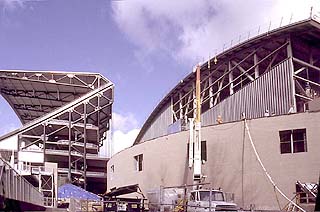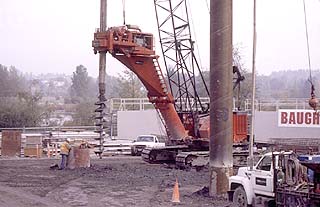|
Subscribe / Renew |
|
|
Contact Us |
|
| ► Subscribe to our Free Weekly Newsletter | |
| home | Welcome, sign in or click here to subscribe. | login |
Construction
| |
 |
September 13, 2001
Can’t get no liquefaction
Skilling Ward Magnusson

Photos courtesy of Skilling Ward Magnusson Barkshire Dempsey Indoor’s exposed structural elements are intended to enhance the architectural design, and echo similar elements in Husky Stadium (pictured on the left).
|
The structural design of the University of Washington’s new covered practice facility presented several challenges, starting literally with the ground up.
Driven by the need for shelter from Seattle’s persistently leaky skies, the university wanted a facility that could address the requirements of various football practice configurations, together with the versatility to accommodate other indoor athletic practices such as track and women’s baseball.
This dictated a structure with a large clear area, incorporating long spans and a high roof. However, the desire for built-in flexibility and the ability to adapt portions of the facility to more intimate practice venues shaped the building mass into a visually appealing combination of high and low.
The ground rather than the building itself presented the first structural obstacle. Prior to the lowering of Lake Washington in 1916, the site was mostly under water. When the lake was lowered to its present level, the site emerged.
Although the area was originally carved by glaciers, creating a very hard surface below-grade at depths ranging from 30 to 100 feet, the site had filled with lake-bottom “muck” over thousands of years. These layers of peat and sand were covered with additional soils between 1940 and 1960 from materials excavated during construction of Interstate 5 and state Route 520. The layering of these varying ground materials created an unstable soil condition. In fact, during the 1965 Seattle earthquake, the grass playing field tore open and large geysers of sand and water spurted out onto the field!
To deal with these conditions and the site’s high liquefaction potential, a pile-supported facility was developed. In the event of a large earthquake, the soils may liquefy, but the facility remains standing above, essentially as one thinks of a pier.
The structural design incorporated 55 3-foot-diameter piles founded in the hard glacial-carved soils under the fill material. In order to drill through the collapsible soils above without cave-ins, 3-foot-diameter steel pipes up to 130 feet long were first driven through the soft soils and embedded into the glacial till. This proved no easy task, as all variety of below-grade materials were encountered, including sunken logs from a sawmill that had once been on the site. Agra Foundations also had to closely monitor the foundation of the adjacent tennis center to avoid any damage.
Once placed, the soil in these pipes was drilled out, with the holes extending as much as 80 feet beyond the end of the pipe. The slope of the underlying lakeshore created a need for progressively longer pilings. The holes and pipes were then filled with reinforced concrete to provide the needed capacity. Although the steel pipes were left in place, the support capacity of the piles actually comes from the reinforced concrete placed inside of the casings. In other words, the pilings are actually designed as concrete instead of steel. The steel casings themselves are expected to corrode away in the highly acidic soils.
Proceeding upward, a typical approach would be to cast a structural slab atop the pilings, on the surface of the soil. However, extensive analysis of the foundation costs led to a more efficient solution. By concentrating the loads into fewer — yet larger — piles, a floor system was developed using economical girders to bridge the required spans. By slightly increasing the cost of the floor framing system, the cost of the piling system was dramatically reduced.
Baugh Construction was brought onto the project early as general contractor/construction manager and provided essential planning for the building. For efficiency in construction, the floor of the playing field was designed using highway-style precast concrete beams topped with a reinforced concrete slab. This allowed Baugh to assemble the precast floor at the same time the steel roof structure was being erected. The huge crane needed for upper roof erection also placed the floor as it backed out of the site, which cut four weeks off the construction schedule.

In order to drill through the collapsible soils above without cave-ins, 3-foot-diameter steel pipes up to 130 feet long were embedded into the glacial till below. Later, the soil in the pipes was drilled out and replaced with reinforced concrete.
|
Early in design, the structure quickly took on a curved-roof shape. To determine that the interior dimensions were appropriate for the trajectories of passed footballs, the design team enlisted the help of then-UW quarterback Brock Huard. Ropes were strung between the upper seats of Hec Edmundson Pavilion, and Huard practiced throwing to his receivers.
Although it was determined that a 50-foot clear height was adequate for passing, a 70-foot clear height was chosen to allow the practice of some aspects of the kicking game. This research further tailored the building into its final shape, which reflects the clear-height requirements of the athletes: a high roof over the full-sized football field and a lower roof over the running track around the field.
The structural system developed incorporates 221-foot roof trusses to create a roof profile that exactly matches the high and low building spaces envisioned by Carlson Architects. The exterior 12-inch-thick reinforced concrete masonry walls stabilize the internally braced steel roof structure. The weight of the roof is carried on 18 2-foot-diameter columns. The columns are steel-filled with reinforced concrete for needed strength and fire resistance. The use of many exposed structural elements enhance the architectural design of this large-volume facility, similar to elements seen in the adjacent Husky Stadium.
Although the center portion of the roof trusses is concealed within the building, the truss ends and supporting columns are purposely located outside the building’s exterior concrete masonry walls. This precaution protects athletes using the running track from inadvertently running into the support columns.
Since the building will be used by different groups of athletes, a system of nets that separate the field and track into various configurations were an integral part of the design. These nets retract into the roof framing when not in use.
Some existing practice facilities throughout the United States are faced with nets that interfere with use even when retracted. For the UW facility, close coordination with the netting contractor during design led to a solution of braces on just one side of the roof trusses. This allows the netting systems to fully retract into the roof space, without any “dangling ends.” Close coordination also accommodated an elaborate system of cables and winches within the structural system.
The structural system and soils were put to a real-life test when the partially completed building was subjected to the Nisqually earthquake on Feb. 28. Although there was evidence of ground settlement, the building itself remained undamaged, as expected.
Howard Burton is a senior associate at Skilling Ward Magnusson Barkshire. He was structural project manager for the Dempsey Indoor practice facility.
Other Stories:
- NW schools spend big to play indoors
- Versatile structure is built to fit
- Husky practice building gives designers a workout
- Bright lights, big facility


